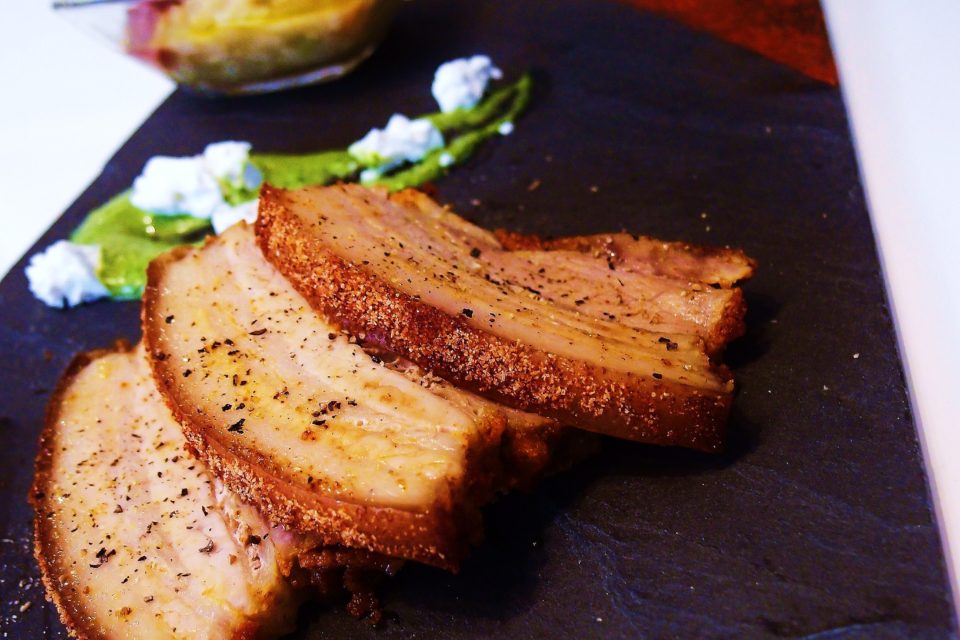With Pinot Noir
Ingredients
Pork belly
- 800 g Pork belly (unsalted)
- 2 tbsp. salt
Spice blend
- 1 1/2 tbsp. mild paprika powder
- 1 1/2 tbsp. garlic powder
- 1 1/2 tbsp. onion powder
- 1 1/2 tbsp. salt
Confit tomato Risotto
Risotto
- 3 dl / 1 1/4 c good quality Arborio rice
- 1 yellow onion
- 1 small carrot
- 2 stalks of celery
- 1 1/2 dl / 1/2 c white wine
- 2 large garlic cloves
- 3/4 dl / 1/3 c oil of choice (e.g. olive or rapeseed)
- 3 vegetable stock cubes (30g)
- 1 1/2 L water
- 1 tbsp. butter
- 1/2 tbsp. salt
- black pepper
Blackened tomatoes
- 400 g cherry tomatoes
- 2 dl oil of choice
- 1 tsp. salt
Herb emulsion
- 10 g flat leaf parsley
- 1 dl olive oil
- 1 garlic clove
- 1/2 tbsp. white balsamic
- 1/4 tsp. salt
- 1 egg yolk
Topping
- 100 g goat cheese
Plating
- rectangular plates
- small portion-sized bowls
- olive oil
- black pepper
Preparation
Pork belly
- Turn oven on to 185C/365F.
- In a large pot simmer pork belly for 15 minutes using 2L of water and 2tbs of salt (the water mayspatter, be careful.)
- While waiting blend together the spices and 1,5 tbs of salt in a large bag.
- Drain the pork belly and place it in the bag of spices close the bag tightly and shake until the pork belly is evenly covered.
- Put the pork belly in 185C/365F oven for 45min.
- If the risotto and rest of the meal isn’t ready at the same time as the pork, just turn the oven off and leave the pork belly inside, it wont dry out due to its high fat content.
Risotto
- To simplify prep-process, roughly chop onion, carrot and celery and then using a food processor mince them all separately, carrot and celery should be quite finely chopped.
- Start the confit tomatoes. See below.
- Sauté onion with 3/4dl oil of choice, 4 dl water and 1/2tbs of salt on high/medium-high heat in a large skillet stirring occasionally until golden, about 10 minutes.
- Make bouillon in a large pot by simmering 1,5L of water and adding 3 vegetable stock cubes, let dissolve, continue on a low simmer.
- Add rice to onion in the pan and toast about 2-3 min on medium heat.
- Add 2 ladles of bouillon and stir in, continue as such, stirring occasionally. There should always be liquid in the pan.
- Let simmer for about 15min before adding 1dl of wine, carrot & celery.
- When the rice kernels still have quite a bite to them, after about 25 min of cooking, turn off the heat.
- Press in 2 garlic cloves, add in 2 more ladles of bouillon, 1tbs of butter, 1/2dl of white wine, and salt and pepper to taste.
- Lastly carefully add the drained confit tomatoes, and black pepper to taste.
Confit tomatoes
- In a sauté pan, pour in 2dl of oil, 400gr of cherry tomatoes, and 1tsp of salt.
- Cook on medium, to medium high heat for 50min. Shake the pan once in a while so that the tomatoes brown evenly, they should be slightly blackened when finished.
- If you have a splatter guard this is a good time to use it, otherwise be careful of hot oil spatter.
- Drain the tomatoes and set aside.
Herb emulsion
- Chop 10gr of herbs, and 1 garlic clove.
- Add together with 1/2dl olive oil, 1/2 tbs white balsamic vinegar, 1/2 tsp salt and 1 egg yolk to a wide mug or small bowl.
- Emulsify using hand mixer.
Plating
- Make sure the risotto is still nice and loose, if not stir in some warm water.
- Slice the pork belly in 1cm thick slices, skin side down, with a sharp serrated knife.
- Plate the risotto in small bowls, top with fresh cracked black pepper.
- Place bowls on one side of the rectangular plates, on the other side put three slices of the pork belly and top off the pork with a brushing of olive oil.
- In the centre of the plate slide on a spoonful of herb emulsion and top it off generously with dollops of goat cheese!
- For an extra garnish, “stencil” some paprika powder on the corner of each plate, using the back of a knife to create a sharp edge (optional).
